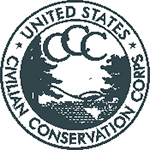History of Blue Knob State Park
The first settlers to Blue Knob arrived soon after the American Revolution. These Pennsylvania Germans moved from eastern Pennsylvania to clear and farm land near the fledgling town of Pavia.
Early industries were:
- Several distilleries in 1812
- Log mill in 1833
- Gristmill in 1843
In the late 1800s, logging companies based out of South Fork, clear-cut the forests of hemlock.
Lumber was hauled away on steam railroads that snaked up the steep hillsides. The lumber companies closed from November to March because the railroad could not operate in the severe winter weather.
One railroad followed Bobs Creek and needed six switchbacks to descend the rugged grade. A State Game Lands 26 service road now follows this old railroad grade.
Another steam railroad followed Wallacks Branch through five switchbacks. Lost Turkey Hiking Trail follows this old railroad grade.
In 1935, the National Park Service created the Blue Knob National Recreation Demonstration Area to provide recreation to the people of Altoona and Johnstown.
The Works Progress Administration employed local workers to build cabins, hiking trails, and roads.

Civilian Conservation Corps (CCC) Company 2327 arrived in October of 1939. After building Camp NP-7, the young men aided in creating the park recreational facilities. World War II ended the CCC.
On September 26, 1945, the National Park Service transferred Blue Knob to the Commonwealth of Pennsylvania and it became Blue Knob State Park.